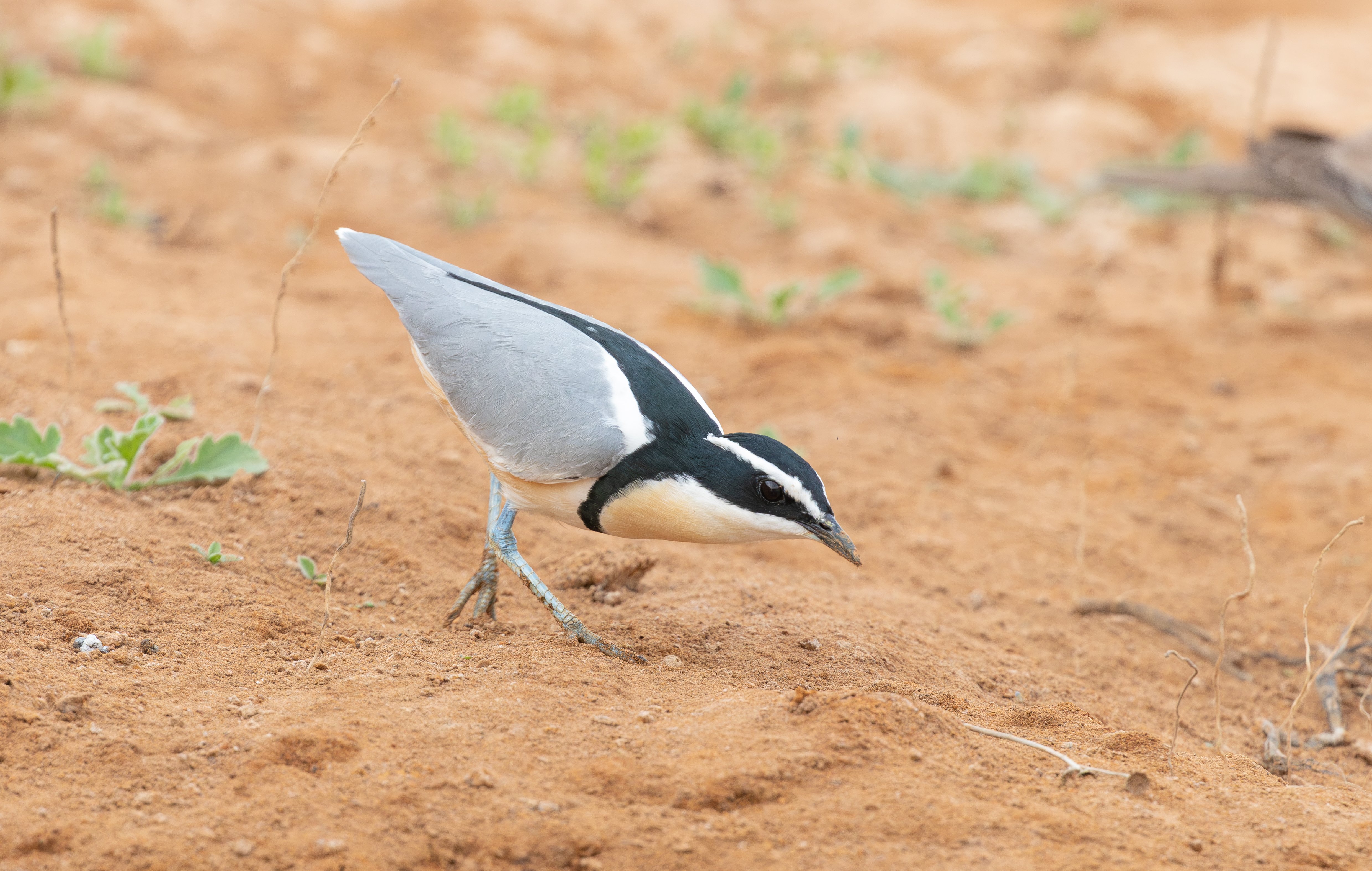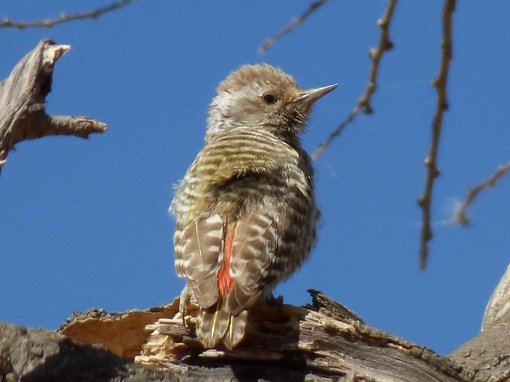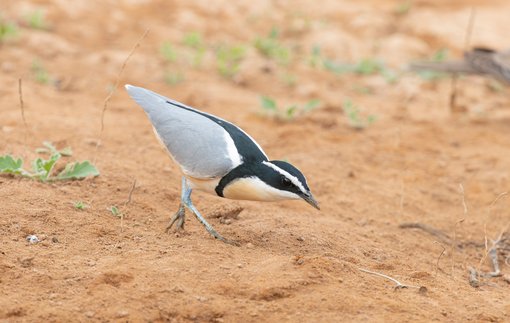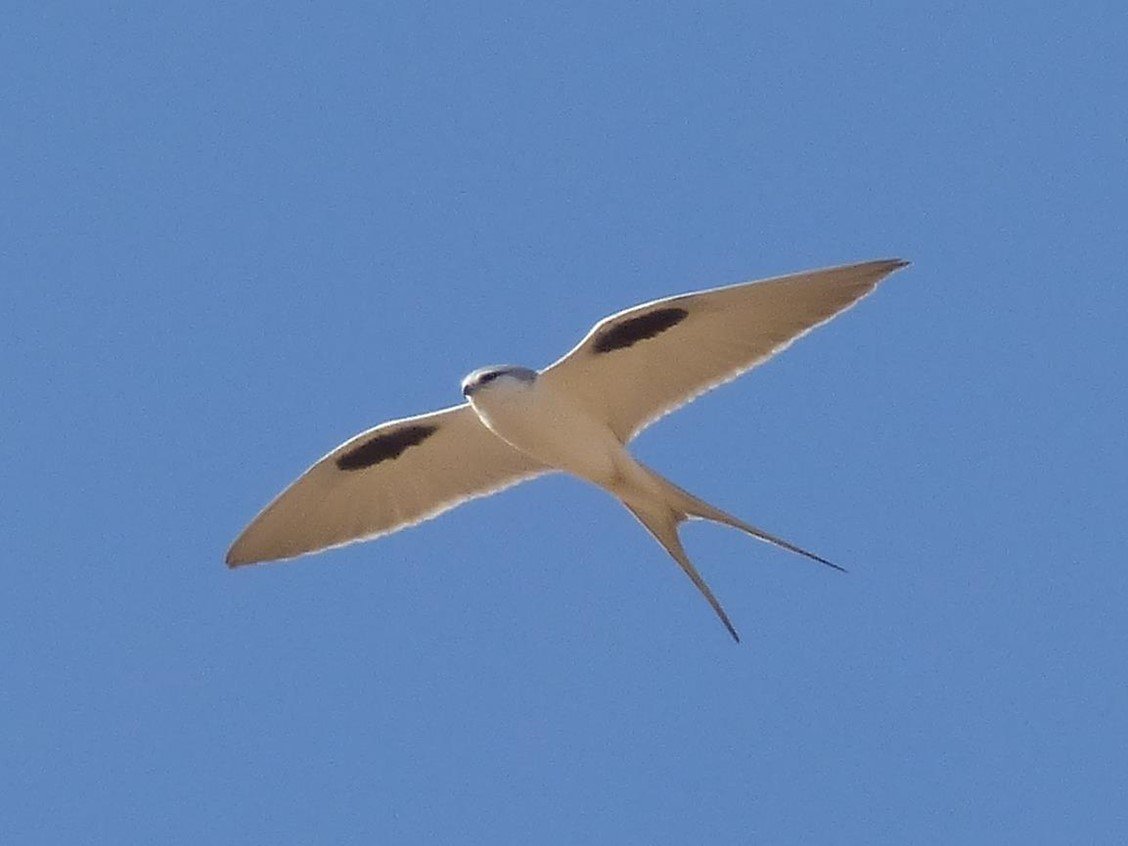Senegal
Specialities of West Africa
An all new small group tour focusing on seeing some of the special birds of sub-Saharan Africa
Although birders regularly visit the small West African country of Gambia, neighbouring Senegal offers the opportunity to see a much more diverse range of species including many which are only found in the Sahel region and on this new and exciting tour we hope to see many of the specialities of the region.
We will start by exploring the sparsely vegetated savannas and grasslands near the Mauritanian border where possibilities include Golden Nightjar, Cricket Warbler, the localised Little Grey Woodpecker, tiny Sennar Penduline Tit and brightly coloured Sudan Golden Sparrow.
We will then head to Djoudj National Park which is considered to be one of the most important protected areas in northern Senegal. The reserve protects an important wetland but also some dry bush habitats where we hope to find the globally threatened Arabian Bustard, with good chances for Savile's Bustard at nearby St Louis. Another Sahel endemic, the River Prinia, is also present and other possibilities include Egyptian Nightjar, Pink-backed Pelican, Greater Painted-snipe, Kittlitz’s Plover, Malachite Kingfisher, Greater Swamp Warbler, Beautiful Sunbird and Vitelline Masked Weaver.
We will then head south visiting an area where we have our first opportunity to find one of Africa’s most-wanted species, the Quail-plover, and if conditions are suitable, we may also find Scissor-tailed Kites hawking over the dry savanna.
The next highlight is likely to be a boat trip to look for the beautiful Egyptian Plover with chances for Pel’s Fishing Owl and mammals such as Hippopotamus, Guinea Baboon and Western Red Colobus Monkey.
This area is also home to African Finfoot, with other possibilities including White-crowned Lapwing, Giant Kingfisher, Grey Kestrel, Adamawa Turtle Dove, Stone Partridge, Bearded Barbet, Yellow-crowned Gonolek, Red-throated Bee-eater, Bronze-tailed and Purple Starlings and Orange-breasted Waxbill.
Our last three nights will be spent at a comfortable lodge in the Saloum Delta. This area is famous for the huge gathering of Scissor-tailed Kites and Lesser Kestrels and we will have the opportunity to take a boat to a remote part of the delta, where we hope to experience the unforgettable sight of thousands of kites and kestrels flying to their roost in the evening light.
Several species which are often hard to see anywhere in Africa can be found here too and we will explore the mangrove-lined waterways and coastal mudflats in search of the elusive, White-crested Tiger Heron. The beautiful White-backed Night Heron is also possible and other species we could encounter include Dwarf Bittern, African Finfoot, Goliath Heron, White-fronted Plover and (the recently split) West African Crested Tern, Palm-nut Vulture, Four-banded Sandgrouse, Bronze-winged Courser, Standard-winged Nightjar, Mottled Spinetail, Swallow-tailed Bee-eater and Purple Roller.
Tour Dates & Prices
Wed 15th January 2025
Tue 28th January 2025
- Fully Booked
Tour Cost: 14 Days from £4595 excluding flights
What's Included?
- Limosa Tour Leader
- 12 nights accommodation in generally comfortable hotels
- All main meals from dinner on day 1 until lunch on day 13
- All surface transport
- All excursions, entry fees and permits
- All tour-based tips and taxes
- Limosa checklist of birds
Cost Excludes
International flights, insurance, drinks, airport and in-flight meals and snacks and other items of a personal nature
Notes
The Land Only Tour Cost is the amount you will pay Limosa.
Despite the end of pandemic restrictions, we have taken the decision to continue to price our holidays as excluding international flights.
To keep the process as simple as possible, we are working very closely with a dedicated agent at Travel Counsellors, Sacha Barbato, who is essentially now our “in house” flight consultant.
Sacha is a highly experienced independent ATOL bonded travel agent, and his contact details are as follows: sacha.barbato@travelcounsellors.com and 01603 360099
He will be able to advise you which flights we are recommending for each holiday and will be able to book these for you.
Tour Highlights
- Superb introduction to the birds of the sub-Saharan Sahel region
- Look for specialities such as Golden Nightjar, Quail-plover, Little Grey Woodpecker, Cricket Warbler, River Prinia and Sudan Golden Sparrow
- Explore Djoudj National Park for Arabian and Savile's Bustards as well as Egyptian Nightjar and numerous waterbirds
- Enjoy boat trips looking for White-crested Tiger Heron, White-backed Night Heron, Egyptian Plover and African Finfoot
- Enjoy the spectacle of hundreds of Swallow-tailed Kites flying to or from their traditional roost site
- Expertly led by Limosa's Frank Lambert and an experienced local Senegalese bird guide
Outline Itinerary
Depart UK for Dakar, Senegal. Transfer to Thiés
Transfer from Thiés to Podor. 2 nights Podor
Explore arid areas, sparsely vegetated savannas and grasslands around Podor
Transfer to St Louis. Begin exploration of Djoudj National Park. Three nights St Louis
Djoudj National Park
Visit Sahelian habitats around the Senegal River near St Louis
Transfer to Kaolack looking for Quail-plover. Night Kaolack
Transfer to Tambacounda. Visit Gambia River at Wassadou on edge of Niokolo-Koba National Park. Two nights Tambacounda
Boat trip on Gambia River looking for Egyptian Plover and African Finfoot
Transfer to Toubacouta. Begin exploration of Saloum Delta. Three nights Toubacouta
Saloum Delta
Enjoy some final birding in Saloum Delta. Transfer to Dakar. Flight to UK
Arrive UK

Whilst the small West African country of Gambia is visited by many birders, neighbouring Senegal offers the opportunity to see a much more diverse range of species and on this new tour we hope to see a fantastic range of specialities including many species which are only found in the Sahel region.
Our tour starts with a flight to Dakar, the capital of Senegal, and we will then head northwards to explore the sparsely vegetated savannas and grasslands near the Mauritanian border. As we drive north to Podor passing Baobab trees and acacia scrub, we can expect to find our first birds with the possibilities including Black-headed Lapwing, Chestnut-bellied Starling and Blue-naped Mousebird.
Although Podor is situated on the southern bank of the mighty Senegal river (and the river valley itself is comparatively lush), the surrounding area is arid and home to an interesting assemblage of birds, some of which are specialised Sahel birds and endemic to this region of semi-desert.
We will search a known site for one of the Sahel’s most enigmatic species, the Golden Nightjar and hope to see this at roost. Other possibilities within the scattered acacia and bushy habitats nearby include Cricket Warbler, the localised Little Grey Woodpecker, diminutive Sennar Penduline Tit, unusually coloured Sudan Golden Sparrow, as well as somewhat more widespread birds such as Black Scrub Robin, Vieillot’s Barbet, Senegal Eremomela, Senegal Batis, Black-crowned Sparrow-Lark and Fulvous Babbler. Both Greyish and Verreaux Eagle-Owls are present in this region and we may go out at dusk to look for them.
We will then travel back westwards following the Senegal River towards the coast to explore the Djoudj National Park. This reserve is considered to be one of the most important protected areas in northern Senegal and there is a large wetland where thousands of wetland birds including the beautiful Black Crowned-Crane and an internationally important population of Great White Pelicans can be found. Other species we could find here include Black Egret, African Pygmy-goose, Pink-backed Pelican, Greater Painted-snipe, Kittlitz’s Plover, Malachite Kingfisher and Greater Swamp Warbler.
There are also some dry bush habitats and these are where we hope to find the majestic Arabian Bustard, a bird which is now globally threatened and has largely disappeared from many other places, such as southern Morocco, where it used to occur. We will also have a very good chance of finding Savile's Bustard at nearby St Louis and another Sahel endemic, the River Prinia, is also present. Other possibilities include Double-spurred Francolin, Egyptian Nightjar, Senegal and Spotted Thick-knees, Senegal Coucal, Beautiful Sunbird and Vitelline Masked Weaver.
We will then head southwards to the town of Kaolack with chances to see multiple species of vultures as we travel including Lappet-faced, Rüppell’s, White-backed and Hooded. This journey will, however, be our first opportunity to look for one of Africa’s most-wanted birds, the Quail-Plover and we plan to explore an area where this with some perseverance we hope to locate it. Assuming the rains have not failed, we should also find Scissor-tailed Kites hawking over the dry savanna.
Continuing onwards, we plan to explorethe periphery pf Niokolo-Koba National Park, where we will take a boat trip to look for the stunning Egyptian Plover. Both Pel’s Fishing Owl and Northern White-faced Owl also roost in the vicinity and the river here also has Hippopotamus with Guinea Baboon, Western Red Colobus and Green Monkeys in the trees nearby.
Another bird we hope to find is the secretive African Finfoot with other possibilities including White-crowned Lapwing, Giant Kingfisher, Grey Kestrel, Adamawa Turtle Dove, Stone Partridge, Bearded Barbet, Yellow-crowned Gonolek, Yellow-billed Shrike, Swamp Flycatcher, Beautiful Sunbird, Red-throated Bee-eater, Blackcap Babbler, Bronze-tailed Starling and Orange-breasted Waxbill.
We will then head back west towards the coast spending our last three nights at a comfortable lodge at Toubacouta, in the Saloum Delta. The delta is famous for its unbelievable gathering of Scissor-tailed Kites and Lesser Kestrels and we plan to make a boat trip to a remote part of the delta where (unless there are extreme drought conditions) we anticipate being able to experience the unforgettable sight of thousands of these birds flying to their roost in the evening light.
As well as the raptor roost, the delta also supports several species which are often hard to see anywhere in Africa and we plan to explore the mangrove-lined waterways and coastal mudflats by boat in search of the often elusive, White-crested Tiger Heron. White-backed Night Heron can also be found here with a very good chance of seeing this beautiful species.
The area also supports birds that we may not have seen elsewhere on the trip, including Yellow-billed Kite, Red-necked Falcon, Beaudouin’s Snake Eagle, Dark Chanting Goshawk, Palm-nut Vulture, Four-banded Sandgrouse, Violet-tipped (or Bronze-winged) Courser, Standard-winged Nightjar, Mottled Spinetail, Swallow-tailed Bee-eater, Purple Roller, Mangrove (or Brown) Sunbirds, Yellow Penduline Tit, Quailfinch and Black-rumped Waxbill.
With a great range of Sahel specialities and other desirable species, this small group holiday offers a fantastic opportunity to explore one of West Africa's best kept secrets.

Day 1
DEPART UK FOR DAKAR
Our holiday starts with a flight to Dakar, the capital of Senegal, from where we will meet our expert local birding guide and then make the short transfer to Thiés for an overnight stay. One night in Thiés
Day 2
THIES TO PODOR
We will drive north from Thiés to the small town of Podor near the Mauritania border for two nights stay. On route, we initially pass excellent savanna habitats that gradually change to sparse acacia, thorn scrub and sandy landscapes typical of this part of the Sahel, an area of semi-desert south of the Sahara Desert.
Although this is a relatively long drive, we will break the journey with periodic stops to look for the birds of the region, such as raptors, rollers, Black-headed Lapwing, Chestnut-bellied Starling, and Blue-naped Mousebird. We should arrive at our destination in time for some initial exploration around Podor. Two nights in Podor
Day 3
PODOR
The arid areas of sparsely vegetated savannas and grasslands in the vicinity of Podor support an interesting assemblage of birds, some of which are specialised Sahel birds, being endemic to this region of semi-desert.
Sahel birds found in the scattered acacias include Black Scrub Robins, Vieillot’s Barbet, Senegal Eremomela, Senegal Batis, Black-crowned Sparrow-Lark, Rufous-tailed Scrub Robin, Fulvous Babbler, the delightful Cricket Warbler, the localised Little Grey Woodpecker, the diminutive Sennar Penduline Tit, and brightly coloured Sudan Golden Sparrows. With some searching and persistence, we also hope to find a roosting Golden Nightjar, one of the Sahel’s most enigmatic species.
There are plenty of other species that we might see whilst searching for these Sahel species, such as Short-toed Snake Eagle, Lanner, Barbary and Red-necked Falcons, Cream-coloured Courser, Laughing and Mourning Doves, Striped Kingfisher, Black Scimitarbill, several species of bee-eater, Western Red-billed Hornbill, African Grey Woodpecker, Singing Bush Lark, Black-crowned and Chestnut-backed Sparrow-Larks, Desert Cisticola, Northern Crombec, Black-crowned Tchagra, Southern Grey Shrike, Northern Grey-headed Sparrow, White-billed Buffalo, Speckle-fronted and Little Weavers.
We are also likely to encounter northern migrants that winter in this area, including such species as Pallid Harrier, Woodchat Shrike, Western Black-eared Wheatear, and a variety of warblers.
As well as Golden Nightjar, both Greyish and Verreaux Eagle-Owls are present in this region, and we will be keeping a special eye out for these.
Day 4
PODOR TO DJOUDJ NATIONAL PARK
After some final birding in the arid Sahel, we will head westwards to the border with Mauritania in the vicinity of Djoudj National Park for an overnight stay. Three nights in St Louis
Day 5
DJOUDJ NATIONAL PARK
Djoudj National Park provides critical wetland and other habitats for a huge number of birds and is considered to be one of the most important protected areas in northern Senegal.
Whilst famous for the diversity and incredible numbers of waterbirds in the national park, the dry bush of Djoudj protects an important population of the globally threatened Arabian Bustard. Illegal hunting has made this species very wary, but there is a good chance to find some in the area. We also hope to find River Prinia, another Sahel endemic.
As well as a good selection of duck, cormorants, herons, storks, egrets, waders, gulls and terns the saline lagoons of Djoudj National Park also support good numbers of flamingos, as well as Black Crowned Crane and an internationally important population of Great White Pelicans. If time allows, we will make a short visit by boat to the pelican breeding colony.
Other birds we are hope to encounter in the vicinity of Djoudj NP and St Louis, where the Senegal River reaches the sea, include Montagu’s Harrier, White-breasted Cormorant, Pink-backed Pelican, Little Bittern, Squacco Heron, Sacred Ibis, Eurasian and African Spoonbills, African Fish Eagle, Greater Painted-snipe, Collared Pratincole, Kittlitz’s Plover, Slender-billed, Gull, Malachite Kingfisher, Greater Swamp Warbler, and with luck, Allen’s Gallinule, Marbled Duck, Quailfinch, Aquatic Warbler, Egyptian and Long-tailed Nightjar.
Mammals we could see in the area include Common Warthogs, Patas Monkey and Golden Jackal.
Day 6
ST LOUIS
The Sahelian habitats to the east and south of the Senegal River near St Louis supports a good number of the scarce Savile’s Bustard, which will be the main target during our visit to this area. We would also hope to find species such as Black Egret, African Pygmy-goose, Senegal and Spotted Thick-knees, Double-spurred Francolin, Senegal Coucal, Western Plantain-eater, Green Wood Hoopoe, Anteater Chat, Beautiful and Scarlet-chested Sunbirds, Vitelline Masked Weaver and Pin-tailed Whydah.
Day 7
ST LOUIS TO KAOLACK
Our drive southwards to the town of Kaolack is a good area for Lappet-faced Vulture, Rüppell’s, White-backed and Hooded Vultures and we will be looking out for these on our journey.
Further south we pass an area where we have our first opportunity to find one of Africa’s most-wanted species, the Quail-Plover. Finding this species depends not only on perseverance but also on the vagaries of the preceding rainy season: it is very difficult to find if the rains have failed. Providing this is not a drought year, we should also find Scissor-tailed Kites hawking over the dry savanna. One night in Kaolack
Day 8
KAOLACK TO TAMBACOUNDA. EXPLORE NIOKOLO-KOBA NATIONAL PARK
During the morning, we will have our second opportunity to look for Quail-Plover in an area of arid grassland and bush. Other species we might encounter in the area include Savile’s Bustard, Piapiac, Sahel Paradise Whydah and Green-winged Pytilia.
Later in the day, we will head for the Tambacounda, where we will stay the night, but we should have time to visit the river at Wassadou, on the edge of Niokolo-Koba National Park, where we will take a boat trip to look for the beautiful Egyptian Plover and other birds.
Pel’s Fishing Owl is occasionally seen on boat trips at this time of day, and Northern White-faced Owl also occur in the vicinity. The river here also has Hippopotamus and there are Guinea Baboon, Western Red Colobus and Green Monkeys in the trees nearby. Two nights in Tambacounda
Day 9
GAMBIA RIVER BOAT TRIP
We will need to leave Tambacounda very early so that we can take a second boat trip on the Gambia River during the early morning. Apart from Egyptian Plover, the river and adjacent habitat also holds African Finfoot, which we have a very good chance of encountering during our stay, as well White-crowned Lapwing, Giant Kingfisher whilst adjacent habitats support Grey Kestrel, Adamawa Turtle Dove, Stone Partridge, Bearded Barbet, Yellow-crowned Gonolek, Yellow-billed Shrike, Swamp Flycatcher, Beautiful Sunbird, Red-throated Bee-eater, Blackcap Babbler, Bronze-tailed and Purple Starlings, Piapiac and Orange-breasted Waxbill.
Day 10
EXPLORE SALOUM DELTA
From Wassadou, we will head back west towards the coast, where we will spend our last three nights at a comfortable lodge at Toubacouta, in the Saloum Delta. The delta is famous amongst birders for its unbelievable gathering of Scissor-tailed Kites and Lesser Kestrels.
Once we arrive in Toubacouta, we plan to make a boat trip to Kousmar, a remote part of the delta, where (unless there are extreme drought conditions) we should have the opportunity to experience the unforgettable sight of thousands of Swallow-tailed Kites and Lesser Kestrels flying to their roost in the evening light. Three nights in Toubacouta
Day 11-12
CONTINUE EXPLORATION OF SALOUM DELTA
As well as the raptor roost, the Saloum Delta supports several species that are often hard to see anywhere in Africa. In particular, we plan to explore the mangrove-lined waterways and coastal mudflats by boat in search of the often elusive, White-crested Tiger Heron, which is regularly seen here. White-backed Night Heron is also here, and there is a very good chance of seeing this beautiful species.
Other species we might encounter include Dwarf Bittern, African Finfoot, Goliath Heron, White-fronted Plover, a variety of wintering waders, and West African Crested Tern (which is now regarded as a different species from Royal Tern).
The Saloum area also supports birds that we may not have seen elsewhere on the trip, including Yellow-billed Kite, Red-necked Falcon, Beaudouin’s Snake Eagle, Dark Chanting Goshawk, Palm-nut Vulture, Four-banded Sandgrouse, Violet-tipped (or Bronze-winged) Courser, Standard-winged Nightjar, Mottled Spinetail, Swallow-tailed Bee-eater, Purple Roller, Mangrove (or Brown) Sunbirds, Yellow Penduline Tit, Quailfinch and Black-rumped Waxbill.
Day 13
SALOUM DELTA. FLY TO UK
After a last morning in the Saloum Delta and some lunch, it will be time to return to Dakar airport for our flight back to the UK.
Day 14

WHAT TO EXPECT
Limosa’s Senegal birding tour focuses on finding a fantastic range of the specialities in this bird-rich West African country. We will concentrate on looking for Sahel and sub-Saharan species including Quail-plover Scissor-tailed Kite, Golden Nightjar, Cricket Warbler, River Prinia, Little Grey Woodpecker, Sennar Penduline Tit and Sudan Golden Sparrow as well as both Arabian and Savile's Bustards.
We will also explore a number of the river systems where the possibilities include Egyptian Plover, Greater Painted-snipe, African Finfoot, White-crested Tiger Heron, White-backed Night Heron and Pel’s Fishing Owl as well as mammals such as Hippopotamus and Western Red Colobus Monkey.
We will be making early starts most days as bird activity is at its best during the first few hours of daylight and then again in the mid-late afternoon. On some days, we may have the opportunity for leisurely lunches, and the occasional afternoon siestas before we resume birding again.
Breakfasts and dinners will generally be taken at our lodge/hotel and lunches may be picnics in the field or at a hotel/lodge/restaurant depending on the plans for that particular day.
Our tour is scheduled during the dry season and at a time of year when the temperature is at its most pleasant and on most days it is likely to be in the mid 20s celsius.
There will generally be good to excellent photographic opportunities in the more open habitats we will be exploring
Birds 200-250 species.
Accommodation 12 nights’ accommodation at simple but comfortable hotels with private facilities. We aim to use the best hotels available and many are actually surprisingly good!!
Meals All main meals are included in the tour price commencing with dinner on the evening of Day 1 and concluding with lunch on Day 13.
Breakfasts and dinners will generally be at our hotel, whilst some lunches will be picnics.
Walking Easy to moderate on generally flat ground. When searching for birds such as Golden Nightjar and Quail-plover, we may have to cover a few kilometres but all walks are optional and as we spend two or more nights at the majority of the places where we stay, the option to opt out on a given day is there.
Sturdy walking shoes with a good grip are recommended.
Weather A dry desert climate, mainly warm and sunny. Although rainfall is always possible, our tour is scheduled in the dry season when the region only average 300mm of rain.
Flights Despite the end of many pandemic restrictions, it is still proving extremely difficult to predict future flight prices and schedules. As a result, we have taken the decision to continue to price our holidays as excluding international flights.
To keep the process as simple as possible, we are working very closely with a dedicated agent at Travel Counsellors, Sacha Barbato, who is essentially now our “in house” flight consultant.
Sacha will be able to advise you which flights we are recommending for each holiday, and he will be able to book these for you.
Ground Transport By minibus.
Photography Good to excellent photographic opportunities in more open habitats, including the various wetlands we visit.

Tour Gallery
View a gallery of images for this tour below, click on an image to view as full size with caption




























